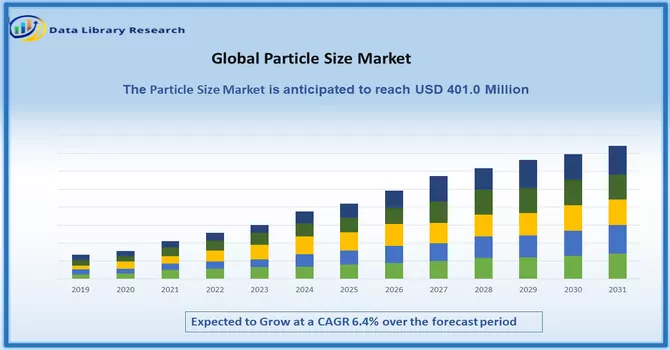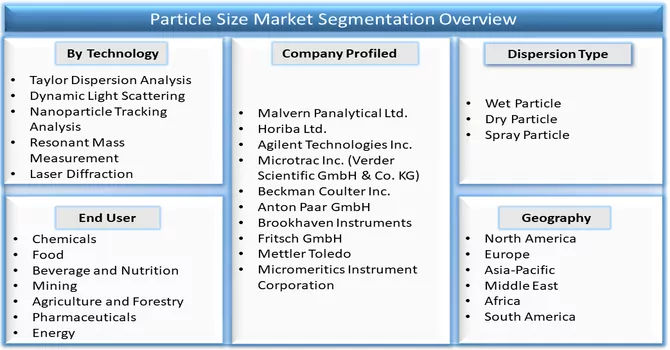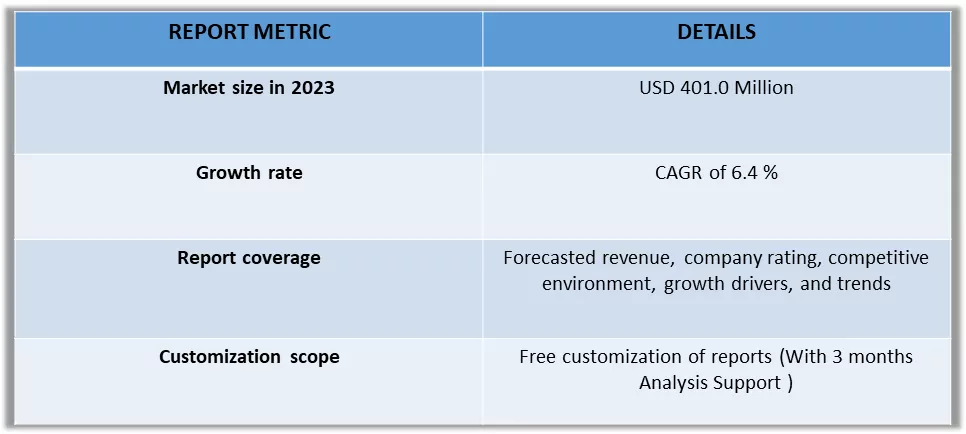The global particle size analysis market size was estimated at USD 401.0 million in 2023 and is expected to expand at a compound annual growth rate (CAGR) of 6.4% from 2024 to 2031.

Get Complete Analysis Of The Report- Download Free Sample PDF
Particle size analysis is a critical component in various industries, ranging from pharmaceuticals and chemicals to food and mining. This market revolves around instruments and techniques designed to measure and analyze the size distribution of particles in a given sample. With applications spanning research and development, quality control, and process optimization, particle size analysis aids industries in understanding and enhancing their products. Advanced technologies, including laser diffraction, dynamic light scattering, and image analysis, contribute to accurate and efficient particle size measurements. The demand for precise characterization of particle sizes, crucial for product performance and compliance with regulatory standards, propels the growth of the particle size analysis market.
The growth of the Particle Size Analysis market is primarily driven by the increasing demand for nanotechnology applications across various industries. As industries delve deeper into nanomaterials and nanoparticles for their unique properties and functionalities, the need for precise and reliable particle size analysis becomes paramount. This analytical technique plays a crucial role in characterizing nanomaterials, ensuring quality control, and optimizing processes in sectors such as pharmaceuticals, cosmetics, and materials science. The expanding applications of nanotechnology, coupled with a focus on improving product quality and performance, contribute to the sustained growth of the Particle Size Analysis market.
Market Segmentation: Nanoparticle Size Analysis and it is segmented by Technology (Taylor Dispersion Analysis, Dynamic Light Scattering, Nanoparticle Tracking Analysis, Resonant Mass Measurement, Laser Diffraction), Dispersion Type (Wet Particle, Dry Particle, Spray Particle), End-user Industry (Chemicals, Food, Beverage, and Nutrition, Mining, Agriculture and Forestry, Pharmaceuticals, Energy), and Geography (North America, Europe, Asia-Pacific, Latin America, Middle East & Africa). The market size and forecasts are provided in terms of value (in USD million) for all the above segments.

For Detailed Market Segmentation - Download Free Sample PDF
The Particle Size Analysis market is witnessing several key trends that are shaping its trajectory. One prominent trend is the integration of artificial intelligence (AI) and machine learning (ML) algorithms in particle size analysis instruments. This integration enhances the accuracy and speed of particle size measurements, allowing for more efficient and reliable results. Additionally, there is a growing emphasis on multi-dimensional analysis, where particle size is assessed along with other parameters like shape and composition. This holistic approach provides a comprehensive understanding of particulate systems, catering to the evolving needs of industries such as pharmaceuticals, food and beverages, and environmental monitoring. Furthermore, advancements in software solutions are facilitating user-friendly interfaces and real-time data analysis, contributing to the overall market trends in Particle Size Analysis.
Market Drivers:
Growing Demand Across Industries
The increasing demand for particle size analysis is driven by its critical role across diverse industries such as pharmaceuticals, chemicals, food and beverages, and environmental monitoring. In pharmaceuticals, for instance, precise particle size analysis is crucial for drug formulation and quality control. Similarly, in the food and beverages industry, it is essential to ensure product quality and optimizing manufacturing processes. This widespread applicability across sectors propels the demand for particle size analysis instruments.
Technological Advancements in Instrumentation
Continuous advancements in particle size analysis instrumentation, including laser diffraction, dynamic light scattering, and imaging techniques, contribute significantly to the market's growth. Technological innovations have led to instruments with improved accuracy, sensitivity, and speed, making particle size analysis more efficient and reliable. The development of user-friendly software interfaces and automated systems further enhances the adoption of particle size analysis across industries, driving the market forward.
Market Restraints:
The particle size analysis market faces certain constraints that impact its growth trajectory. One key challenge is the high initial capital investment required for advanced particle size analysis instruments. The sophisticated technologies involved in laser diffraction, dynamic light scattering, and other methods often come with a substantial cost, limiting accessibility for smaller enterprises. Additionally, the complexity of these instruments may necessitate specialized training for operators, further adding to the overall cost of implementation. Moreover, regulatory challenges and standardization issues in particle size measurement methods can create barriers, hindering the seamless adoption of these technologies across different industries. Addressing these constraints will be crucial for unlocking the full potential of particle size analysis in various applications.
The global particle size analysis market experienced notable shifts in the wake of the COVID-19 pandemic. The restrictions imposed to curb the virus's spread disrupted supply chains, leading to delays in the production and delivery of particle size analysis equipment. Laboratories and research facilities faced operational challenges, with many temporarily shutting down or operating at reduced capacity. The heightened focus on healthcare priorities during the pandemic led to a surge in demand for particle size analysis in pharmaceutical research, particularly in vaccine development and drug formulation processes. On the other hand, industries such as mining and construction, which heavily rely on particle size analysis for material characterization, witnessed a slowdown. As the world adapts to the new normal, the particle size analysis market is expected to recover, driven by increased research activities, stringent quality control requirements, and the resurgence of diverse industries.
Segmental Analysis:
Taylor Dispersion Analysis Segment is Expected to Witness Significant Growth Over the Forecast Period
Taylor Dispersion Analysis (TDA) is a sophisticated analytical technique used in the particle size market to determine the size distribution of particles in a sample. TDA measures the diffusion of a solute in a solvent, providing valuable information about the size of particles in the sample. This technique is particularly useful in industries such as pharmaceuticals, chemicals, and materials science, where precise control of particle size is critical for product performance and quality. The particle size market, driven by increasing demand for high-quality products with specific particle size requirements, is expected to grow significantly in the coming years. TDA's ability to provide accurate and reliable particle size analysis positions it as a valuable tool in this market, offering manufacturers the insights needed to optimize their processes and deliver superior products to consumers.
Wet Particle Segment is Expected to Witness Significant Growth Over the Forecast Period
The wet particle segment is a key component of the particle size market, offering a method to analyze particles in a liquid medium. Wet particle sizing is particularly useful for measuring particles that are prone to agglomeration or are sensitive to drying processes. This segment utilizes techniques such as dynamic light scattering (DLS), laser diffraction, and nanoparticle tracking analysis (NTA) to accurately determine the size distribution of particles in a liquid suspension. Industries such as pharmaceuticals, biotechnology, and cosmetics rely on wet particle sizing for quality control and research purposes. As the demand for precise particle size analysis continues to grow across various industries, the wet particle segment is expected to play a crucial role in meeting these evolving needs.
Food, Beverage, and Nutrition Segment is Expected to Witness Significant Growth Over the Forecast Period
In the food, beverage, and nutrition industries, particle size analysis plays a critical role in ensuring product quality, consistency, and consumer satisfaction. Particle size affects the texture, flavor, and appearance of food and beverage products, making it essential for manufacturers to control and optimize particle size distribution. In the food industry, particle size analysis is used to measure ingredients, such as flour, sugar, and spices, to ensure they meet specific size requirements for consistent product formulation. In beverages, particle size analysis is crucial for controlling the size of suspended particles, such as pulp in fruit juices or sediment in wine, to enhance product clarity and stability. In the nutrition industry, particle size analysis is used to optimize the bioavailability of nutrients and active ingredients in supplements and functional foods. Overall, the food, beverage, and nutrition industries rely on particle size analysis to meet regulatory requirements, improve product quality, and enhance consumer satisfaction.
North America Region is Expected to Witness Significant Growth Over the Forecast Period
In the North American region, the particle size market is witnessing significant growth, driven by factors such as technological advancements, increasing demand for quality assurance in various industries, and stringent regulatory requirements. Particle size analysis is crucial in industries such as pharmaceuticals, chemicals, food and beverage, and mining, where it is used to ensure product quality, optimize processes, and meet regulatory standards. North America's strong presence in these industries, coupled with a focus on research and development, makes it a key market for particle size analysis instruments and services. Additionally, the region's robust infrastructure and high adoption of automation and digitalization further contribute to the growth of the particle size market. As industries continue to prioritize efficiency, quality, and regulatory compliance, the demand for particle size analysis solutions in North America is expected to continue to rise.

Get Complete Analysis Of The Report- Download Free Sample PDF
The analyzed market exhibits a high degree of fragmentation, primarily attributable to the presence of numerous players operating on both a global and regional scale. The competitive landscape is characterized by a diverse array of companies, each contributing to the overall market dynamics. This fragmentation arises from the existence of specialized solution providers, established industry players, and emerging entrants, all vying for market share. The diversity in market participants is underscored by the adoption of various strategies aimed at expanding the company presence. On a global scale, companies within the studied market are strategically positioning themselves through aggressive expansion initiatives. This often involves entering new geographical regions, targeting untapped markets, and establishing a robust global footprint. The pursuit of global expansion is driven by the recognition of diverse market opportunities and the desire to capitalize on emerging trends and demands across different regions. Simultaneously, at the regional level, companies are tailoring their approaches to align with local market dynamics. Regional players are leveraging their understanding of specific market nuances, regulatory environments, and consumer preferences to gain a competitive edge. This regional focus allows companies to cater to the unique needs of local clientele, fostering stronger market penetration. To navigate the complexities of the fragmented market, companies are implementing a range of strategies. These strategies include investments in research and development to stay at the forefront of technological advancements, mergers and acquisitions to consolidate market share, strategic partnerships for synergies, and innovation to differentiate products and services. The adoption of such multifaceted strategies reflects the competitive nature of the market, with participants continually seeking avenues for growth and sustainability. In essence, the high fragmentation in the studied market not only signifies the diversity of players but also underscores the dynamism and competitiveness that drive ongoing strategic maneuvers. As companies explore various avenues for expansion, the market continues to evolve, presenting both challenges and opportunities for industry stakeholders.
Particle Size Analysis Companies:
Recent Development:
1) In June 2023, Malvern Panalytical unveiled its NanoSight Pro nanoparticle tracking analysis (NTA) system. This cutting-edge system revolutionizes the characterization of nanomaterials, offering users the capability to generate highly reproducible, robust data swiftly. The incorporation of machine learning, coupled with intelligently programmed features, streamlines the analysis process, ensuring efficiency and precision in nanoparticle tracking.
2) In April 2023, Horiba Advanced Techno, Co., Ltd., a subsidiary of the Horiba Group, made headlines with its acquisition of Tethys Instruments SAS. Tethys Instruments specializes in the design, manufacturing, and sale of water quality monitoring equipment tailored for both environmental and industrial applications. This strategic move reinforces Horiba's commitment to advancing its capabilities in the realm of water quality monitoring, aligning with evolving industry needs.
Q1. What was the Particle Size Market size in 2023?
As per Data Library Research the global particle size analysis market size was estimated at USD 401.0 million in 2023.
Q2. At what CAGR is the Particle Size market projected to grow within the forecast period?
Particle Size Market is expected to expand at a compound annual growth rate (CAGR) of 6.4% over the forecast period.
Q3. What are the factors driving the Particle Size market?
Key factors that are driving the growth include the Growing Demand Across Industries and Technological Advancements in Instrumentation.
Q4. Who are the key players in Particle Size market?
Some key players operating in the market include
Data Library Research are conducted by industry experts who offer insight on industry structure, market segmentations technology assessment and competitive landscape (CL), and penetration, as well as on emerging trends. Their analysis is based on primary interviews (~ 80%) and secondary research (~ 20%) as well as years of professional expertise in their respective industries. Adding to this, by analysing historical trends and current market positions, our analysts predict where the market will be headed for the next five years. Furthermore, the varying trends of segment & categories geographically presented are also studied and the estimated based on the primary & secondary research.
In this particular report from the supply side Data Library Research has conducted primary surveys (interviews) with the key level executives (VP, CEO’s, Marketing Director, Business Development Manager and SOFT) of the companies that active & prominent as well as the midsized organization
FIGURE 1: DLR RESEARH PROCESS

Extensive primary research was conducted to gain a deeper insight of the market and industry performance. The analysis is based on both primary and secondary research as well as years of professional expertise in the respective industries.
In addition to analysing current and historical trends, our analysts predict where the market is headed over the next five years.
It varies by segment for these categories geographically presented in the list of market tables. Speaking about this particular report we have conducted primary surveys (interviews) with the key level executives (VP, CEO’s, Marketing Director, Business Development Manager and many more) of the major players active in the market.
Secondary ResearchSecondary research was mainly used to collect and identify information useful for the extensive, technical, market-oriented, and Friend’s study of the Global Extra Neutral Alcohol. It was also used to obtain key information about major players, market classification and segmentation according to the industry trends, geographical markets, and developments related to the market and technology perspectives. For this study, analysts have gathered information from various credible sources, such as annual reports, sec filings, journals, white papers, SOFT presentations, and company web sites.
Market Size EstimationBoth, top-down and bottom-up approaches were used to estimate and validate the size of the Global market and to estimate the size of various other dependent submarkets in the overall Extra Neutral Alcohol. The key players in the market were identified through secondary research and their market contributions in the respective geographies were determined through primary and secondary research.
Forecast Model
